Chowringhee
Chowringhee (also spelt Chourangi) is a neighbourhood of Central Kolkata, in Kolkata district in the Indian state of West Bengal. Chowringhee Road (officially Jawaharlal Nehru Road) runs on its western side. A neighbourhood steeped in history, it is a business district,[1] as well as a shopper's destination and entertainment-hotel centre.
Chowringhee | |
|---|---|
Neighbourhood in Kolkata (Calcutta) | |
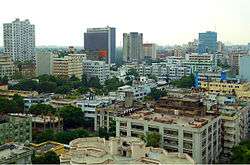 Chowringhee skyline 2011 | |
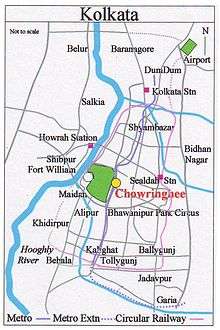 | |
| Coordinates: 23.8°N 88.25°E | |
| Country | |
| State | West Bengal |
| City | Kolkata |
| District | Kolkata |
| KMC wards | 46, 63 |
| Metro Station | Esplanade, Park Street, Maidan and Rabindra Sadan |
| Kolkata Suburban Railway | Eden Gardens, Sealdah, Park Circus |
| Elevation | 36 ft (11 m) |
| Population (2001) | |
| • Total | 159,917 |
| Time zone | UTC+5:30 (IST) |
| PIN | 700013, 700016, 700071, 700087 |
| Area code(s) | +91 33 |
| Lok Sabha constituency | Kolkata Uttar and Kolkata Dakshin |
| Vidhan Sabha constituency | Chowranghee and Bhabanipur |
Etymology
The name ‘Chowringhee’ has defied etymologists. There is, however, the legend of a yogi, Chourangi Giri, who discovered an image of the goddess Kali's face and built the first Kalighat temple.[2]
History
The village
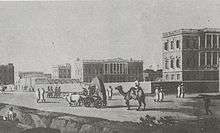
In the seventeenth century or prior to it, the area now occupied by the Maidan and Esplanade was a tiger-infested jungle. At the eastern end of it was an old road, which had once been built by the Sabarna Roy Choudhury family from Barisha to Halisahar. Beyond it there were “pools, swamps and rice-fields, dotted here and there with the straggling huts of fishermen, falconers, wood-cutters, weavers and cultivators. In that region were three small hamlets – Chowringhee, Birjee and Colimba.[3]
In 1717, Chowringhee was a hamlet of isolated hovels, surrounded by water-logged paddy-fields and bamboo-groves separated from Gobindapur by the jungle.[3] Tradition has it that Warren Hastings, hunted with elephants in the jungle.[4] Birjee occupied the south-eastern end of later day Maidan, Victoria Memorial and Rabindra Sadan area. Colimba took its name from the Bengali word for musk melon.[2]
Urbanisation
The strengthening of British power, subsequent to their victory in the Battle of Plassey was followed by the construction of the new Fort William, in 1758. The European inhabitants of Kalikata gradually forsook the narrow limits of the old palisades and moved to around the Maidan.[5] In the mid eighteenth century Englishmen began to build magnificent houses on the Chowringhee that earned Kolkata the title of ‘City of Palaces’.[6]
The first road in Kolkata to be macadamised was Chitpur Road in 1839. In the evening of 6 July 1857 Chowringhee was lit up with gas lights provided by the Oriental Gas Company. Building of pavements started in 1858, first in Chowringhee and then elsewhere. The pavements were built to facilitate the erection of gas lamps. The traders objected as their customers were forced to park their carriages some distance from the shops.[6]
The neighbourhood
The ‘road to Chowringhee’ ran from Lower Circular Road (renamed Acharya Jagadish Chandra Bose Road) in the south to Dharmatala in the north. According to old maps, Chowringhee is a locality, not a road. In Colonel Mark Wood's map of 1784 while the road is marked ‘Road to Chowringhee’, the name ‘Chowringhee’ is given to the locality immediately south of Park Street. However, in Upjohn's map of 1794, this district is marked Dhee Birjee and boundaries of Chowringhee appear as Circular Road on the east, Park Street on the south, Colinga on the north and a portion of ‘Road to Chowringhee’ on the west.[4]
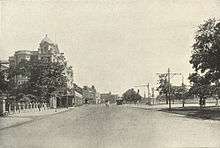
David William Martin
in The changing face of Kolkata
Travelling along the ‘Road to Chowringhee’ from south to north, the first crossing was with Theatre Road (renamed Shakespeare Sarani). At that corner was the Theatre of Calcutta from 1813 to 1839. It was destroyed in a fire. The next turning is that of Harrington Street (renamed Ho Chi Minh Sarani) named after John Herbert Harrington, a judge of the Sadar Adalat. The next crossing Middleton Street was named after Dr. Thomas Fanshaw Middleton, the first Bishop of Kolkata (1814–1822). Right before Middleton Street merges with Chowringhee road, along Chowringhee Road on the right comes The 42, the newest addition to this area. It is the tallest residential building in Kolkata and Eastern India.[8] Further down the road was Bengal Club (it is still there). The building was once the residence of Thomas Babington Macaulay. Behind Bengal Club ran Russel Street (renamed Anandi Lal Poddar Sarani), named after Sir Henry Russel, Chief Justice of the Supreme Court from 1806-1813.[4]
At the next crossing with Park Street (renamed Mother Teresa Sarani), is the Asiatic Society. Park Street is not shown in any map earlier than 1760. In Upjohn's map of 1794 it is called ‘Burial-ground Road’, which means it led to the burial ground on Circular Road. The site of Sir Elijah Impey's residence on Middleton Row now houses Loreto House and Loreto College. St. Xavier's College, the great institution of Jesuit Fathers, was once Sans Souci Theatre. It was formally opened in 1841 and was sold in 1844 to Arch Bishop Carew.[4]
Camac Street (renamed Abanindranath Tagore Sarani) running from Park Street to Circular Road was named after William Camac, a senior merchant in the days of Cornwallis and Wellesley. Wood Street was named after Henry Wood. Free School Street (renamed Mirza Ghalib Street), named after a Free School established there in 1786, was a bamboo jungle in 1780.[4]
The next crossing is that with Kyd Street, named after Lt. Col. Robert Kyd, Military Secretary to the Government of Bengal, who lived on that road. The road was earlier named Chowringhee Tank Street, after the tank that is still there opposite to the crossing with Park Street.[9]
Kironmay Raha
Sudder Street, north of the Indian Museum once housed the Sudder Court. The area beyond it is Colinga (from Colimba) and tank in the Maidan was called Colinga Tank. Lindsay Street leading to the municipal market, was named Robert Lindsay, who had a colourful career with East India Company and once owned a house on the street. The Opera House, a wooden building, was once located on Lindsay Street.[9] Grand Hotel is an important landmark on Chowringhee Road.
New names
Indian independence saw a rush to rename streets. The process has slowed as few streets are left to be renamed. Chowringhee Road was renamed after Jawaharlal Nehru, the first Prime Minister of India. Park Street was renamed after Mother Teresa. Theatre Road was renamed after William Shakespeare. There was no street named after the poet during the long years of British rule in India. Harrington Street was renamed after the leader of the Vietnam independence movement, Ho Chi Minh. Camac Street has been renamed after the great artist Abanindranath Tagore. Russel Street was renamed after industrialist Anandi Lal Poddar. Free School Street was renamed after the Urdu/ Persian poet Mirza Ghalib. Kyd Street was renamed Dr. Md. Ishaque Road. Lindsay Street was renamed after Nellie Sengupta.
Geography
Chowringhee is located in Central Kolkata. It has Janbazar on the north, Taltala and certain areas under Park Street Police Station on the east, Bhawanipore on the south and the Maidan on the west. The neighbourhood is spread over areas under New Market,[11] Park Street[12] and Shakespeare Sarani police stations.[13]
Park Street Flyover was inaugurated on 19 February, 2005. The 1.3 km long flyover above Chowringhee Road helps in reduce the traffic jam between Lindsay Street and Middleton Street.[14]
Creative inspiration
Life in the neighbourhood has inspired creative efforts.
The Bengali novelist Sankar wrote a novel named Chowringhee in 1962 (three years before Arthur Hailey's Hotel). It became an instant hit. Set in Kolkata of the 1950s, it is the saga of the intimate lives of the staff and the guests at the Shahjahan, one of the largest city hotels located in the neighbourhood, which is the title of the novel. Some of its larger-than-life characters, as for example the enigmatic manager Marco Polo, the debonair receptionist Sata Bose, and the tragic hostess Karabi Guha, attained cult status. It has been translated into English by Arunava Sinha and is available as a Penguin paper-back. It has also been translated into several Indian languages.[15] Film director, Pinaki Bhusan Mikherjee made it into a successful film in 1968. It was also made into a play by BBC Four.[16]
In 1981, Aparna Sen wrote and directed a film, 36 Chowringhee Lane, about an aged Anglo-Indian school teacher who lives a lonely life in a single-room flat in the neighbourhood.[17]
Gallery
 Industry House on Abanindranath Tagore Sarani
Industry House on Abanindranath Tagore Sarani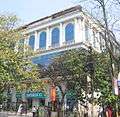 Pantaloon outlet on Abanindranath Tagore Sarani
Pantaloon outlet on Abanindranath Tagore Sarani St. Thomas Church adjacent to Loreto House on Middleton Row
St. Thomas Church adjacent to Loreto House on Middleton Row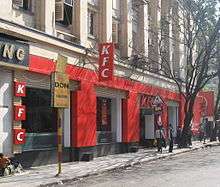 KFC outlet on Middleton Row
KFC outlet on Middleton Row- Middleton Street
 Park Street Flyover
Park Street Flyover
External links
![]()
References
| Wikimedia Commons has media related to Chowringhee. |
- "Tax lawyer is CPM candidate for Chowringhee seat". The Hindu Business Line, 18 February 2006. Retrieved 16 January 2008.
- Nair, P. Thankappan in The Growth and Development of Old Calcutta, in Calcutta, the Living City, Vol. I, edited by Sukanta Chaudhuri, pp. 14-15, Oxford University Press, ISBN 978-0-19-563696-3.
- Cotton, H.E.A., Calcutta Old and New, 1909/1980, p. 19, General Printers and Publishers Pvt. Ltd.
- Cotton, H.E.A., pp. 230-236.
- Cotton, H.E.A., p. 72.
- Nair, P.Thankappan, Civic and Public Services in Old Calcutta, in Calcutta, the Living City, Vol. I, p. 224
- "Now and Then". Choweinghee. kolkatainformation. Archived from the original on 20 April 2008. Retrieved 16 January 2008.
- Tallest in town - 250m tower in heart of the city, by Subhro Saha, The Telegraph, Kolkata.
- Cotton, H.E.A., pp. 244-247
- Raha, Kironmoy, Calcutta Theatre 1835-1944, in Calcutta, the Living City, Vol. I, pp. 186-187
- "New Market Police Station". Kolkata Police. Archived from the original on 27 September 2007. Retrieved 16 January 2008.
- "Park Street Police Station". Kolkata Police. Archived from the original on 16 April 2007. Retrieved 16 January 2008.
- "Shakespeare Sarani Police Station". Kolkata Police. Archived from the original on 8 June 2007. Retrieved 16 January 2008.
- "Park Street Flyover".
- "Details of Chwringhee". Indiatimes Shopping. Archived from the original on 4 June 2007. Retrieved 16 January 2008.
- "Chwringhee (1968)". imdb.com. Retrieved 16 January 2008.
- "36 Chowringhee Lane (1981)". imdb.com. Retrieved 16 January 2008.